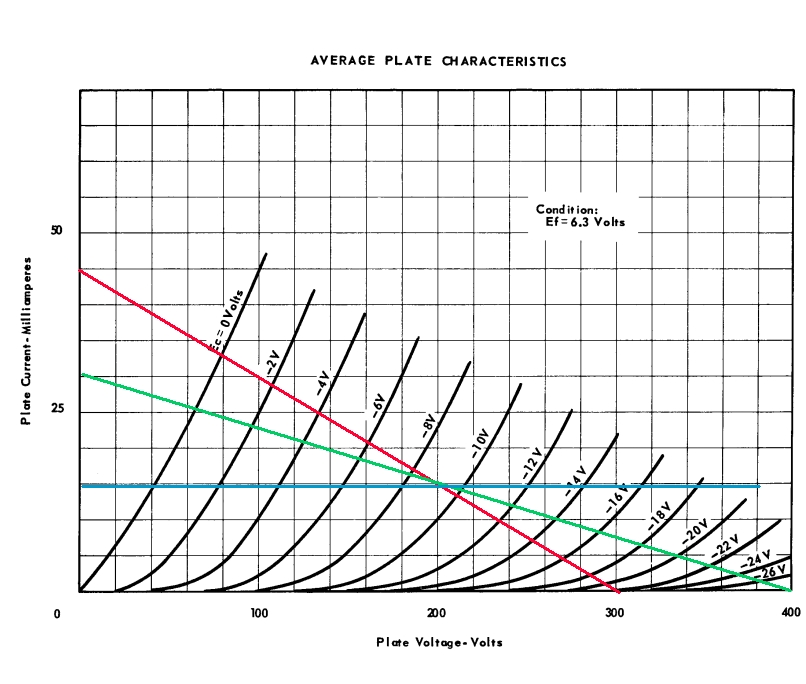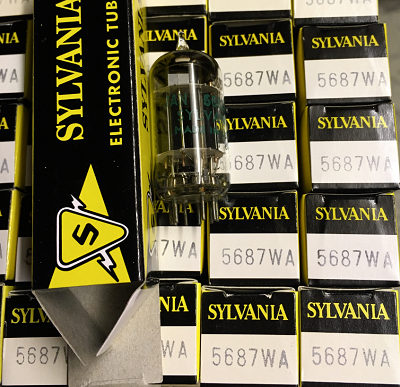Since 1993 Copyright Notice
Attention: This is an export Price List, valid for companies in the European Community with a VAT Identification number, and for companies or private persons outside the European Community. Inside Europe, please ask for a quote, including VAT tax. (Since 2021 we must charge the VAT of the receiving country)
Please also check in the price list under NOS! Not all tubes in the price list are pictured or mentioned here.
5687 Triodes
I think 5687 is one of the most interesting tubes ever made. It has exceptional high heater power, so in any case the glow picture is beautiful. This heater power has another function as just giving light. It provides incredible high emission, which is the source of tube performance. So it has high gain, low impedance, and linearity, long life time, and high reliability, all at the same time. There are hardly any other tubes like this ever made. With 5687, there are two things you can be sure of: First, today's amplifier designers LOVE this tube. Second, this tube is extremely hard to build, because of the exceptional heat development inside. So it was already historically not a commercial tube. NOS supply is low, and any thoughts that Russians or JJ will ever build this tube, is a silly illusion. Their regular materials are far from sufficient for this, and market need for this tube is only in HiFi, and no guitar amplifier ever used it. So the big companies are totally uninterested, and the small companies can NEVER do this. According to New Sensor, who told me this directly, easy to build tubes for guitar amplifiers is 95% of the market. So any troubles with HiFi people who can hear smallest noise, or test tubes electrically, Newsor drops those people like a hot potatoe.
NOS stock however is definitely low everywhere. We are one of the few, having a small stock left, from the 1960's. Nicely assorted over several USA brands. All are tested twice at the AVO CTM163. One time carefully by the person who sold this to me, and one time by me, at incoming inspection. Overall quality of this lot is so great, you can just take two and they are a matched pair already. Similar like with the Toshiba 6SN7 stock I found some years ago, but that is another story.
Clean, colored printing and all in individual boxes. This is NOS as best as can be :) More information about this tube here
5687WA SYLVANIA |
NOS |
60pcs |
See normal price list |
|
These are have data codes from 1962.1966. 5687WA WESTINGHOUSE
|
NOS |
40pcs |
See normal price list |
|
5687 tube - and how to read it's data sheet.
Please click this link here for the data sheet, and briefly read the 8 pages, particularly PAGE 2, 3, and 4. When you see that, all I can say, wow... THAT IS TUBE TESTING!!!! Comparing this to JJ data sheets of for instance ECC82, where they cut out virtually everything which is not necessary to mention, this painfully shows the difference between the finest, and the cheapest.
5687 is a highly unusual tube, worth a few lines here. To learn about particular tubes, there is a "forgotten" source, called "manufacturer data sheet". Do you recognise this situation: People register under fake names on anonymous forums, to ask unknown people. "Tube_Lover" asking "tubeman" if the sound of a square getter is better than a round getter. And they appear sooooo well informed about how they sound, even break that down to the color of the mica and the shape of the glass. Well... I have to pass with that magic. As an engineer, I sometimes ask those people for the metrics. So for the numbers behind those things they say. But as a result I get only letters.
So I have this information from the 5687 data sheet, and in case you find it interesting... I would recommend to read the data sheet yourself.
What does it say there? 5687 is a high reliability tube. Mmm. Well did not we expect that anyway? But you see, expecting is one thing, but that is only yourself. But when it says so in the datasheet, it's a metric, and that means they must give numbers. And yes... they do!
In begins with the introduction text, saying this tube can be used in cut-off applications. And indeed not any random tube is good for that. For a clear and nice cut off, as unlogical as it sounds, a very high emission is beneficial. This ensures the function of the grid stays intact, even at rare condition as total cut off. That is why real professionals are always interested to check if an unknown used tube, cuts off nicely and sharp. That means quality. So if not sharp, like it does cut off 95%, but the last bit of cut off needs more, and more negative grid voltage. Whereas a sharp cut off means, when you are close to cut off, you just give a little bit more negative grid voltage and then the tube cuts off sharply. This high emission, which makes the cut-off so sharp, at the same time means, the tube saturates nicely when you switch something with it, so the tube doesn't get hot, and you don't waste power supply energy on that. A tube like this, is not just ideal for switching, (like in a computer) or switch a high voltage or high current load, like a lamp or a relay, but can be used for many other applications as well. If this is so, and what are the possibilities, you can browse the forums for some babble. But it is a lot more interesting to data sheet first. .
What does it say on the data sheet? There is a signal application too, called Cathode follower. Not everybody may know what this means, but it is just a circuit which has a very low output impedance. What else does it say? This tube characterizes by long life, stabile performance, service under severe conditions of mechanical shock, and vibrations. So we learn here, it is a very probably a low microphonics tube.
5687 can be used where High perveance is needed. Raytheon says. I had to research a little but what that perveance means, but I found out. With that, they want to tell us, the tube can be used at high current and low voltage at the same time. Or in other words, some tubes need higher voltage in order to pull a lot of current, but 5687 can do so at at low voltage already. That again means, emission must be very high.
Then, in the next paragraph, there are a few lines for engineers. It says "TO ELECTRONIC EQUIPMENT DESIGN ENGINEERS". Well, then I hope that people who say this from themselves, will read that. Though my hope on this is small, but we should never to give up hope in life.
So what does Raytheon say to engineers?
- Lifetime will be reduced very much, if used at maximum ratings. (I agree with Ratheon... you can not tell them often enough)
- Reliability and performance are jeopardized, if you exceed filament ratings. (which is +/- 5%) (Same comment at above!!!)
- The closer you are to the heater center value, the longer the tube life will be. (AND AGAIN. Same comment at above!!!)
That is clear language they use there. You have to realize they write this for a such tough, high reliability, military tube. So guess what happens if you disrespect those three points with commercial tubes.
Positive Grid Voltage. Another thing which catches may attention is this:
- Maximum Plate current 36mA (RMS)
- Maximum cathode current 65mA (RMS)
This means the positive grid current can be 29mA. This becomes clear from the graph at Page 7, where you can see a positive grid voltage of +50 Volts. This is incredible high, and in that condition the tube can deliver a stunning 1 Ampere plate current, and 750mA grid current. These values are UNBELIEVABLE for such a tiny tube. I have to admit, that I have difficulties to imagine the intended use for such high numbers, because definitely the tube will not be happy about it. Yet it shows what an amazing tube this is.
Gold Grid. The tubes I checked, all had a gold grid. Though the data sheets do not specify a gold grid specifically, there is probably no other way.
AUDIO USE
Such a great tube can be used for audio also. It is found in many amplifiers, such as: Audio Note M3, Manley Jumbo Shrimp,Ayon CD player, Audio Note DAC 5 Signature and Audio Note amp kits, M5 preamp, M9, KR Enterprise 32BSI integrated SET amp, Modwright 9.0 and Modwright Sony and Denon modded CD players, Modwright Sony NS999ES CD player, Opera Audio Consonance Cyber 800, Zanden, Manley amps, LUX 300B amp,Kondo M1000, Artemis Labs linestage, Emotive Audio Sira, Ray Samuels B52 and Raptor, Audio Tekne TFM-9412, Sonic Frontiers Power 2 Amps, Audio Experience BALANCED A2 preamp (YS-AUDIO, HONG KONG), Ongaku, Audio Note, New Audio Frontiers Legend II preamp, Loth X JI300,Audio Thrills, Mastersound, Sophia Electric KT88 Tube Amplifier, Icon Audio PS3 phono power supply, Almarro.
The unlinear zone is very large too, but this part is intended for the switching applications. For Audio use, you need to operate into the linear zone of the tube curves.

Those load lines are sure not ideal, because I just pencilled them in quickly. I only try do explain why the unlinear zone should be avoided, and then this tube can work nicely distortion free. At the same operating point, where they cross, you can see the red load dives into the unlinear zone, whereas the green load line stays away from there. An even much more ideal behavior is achieved with a grid choke, which is the blue load line.


